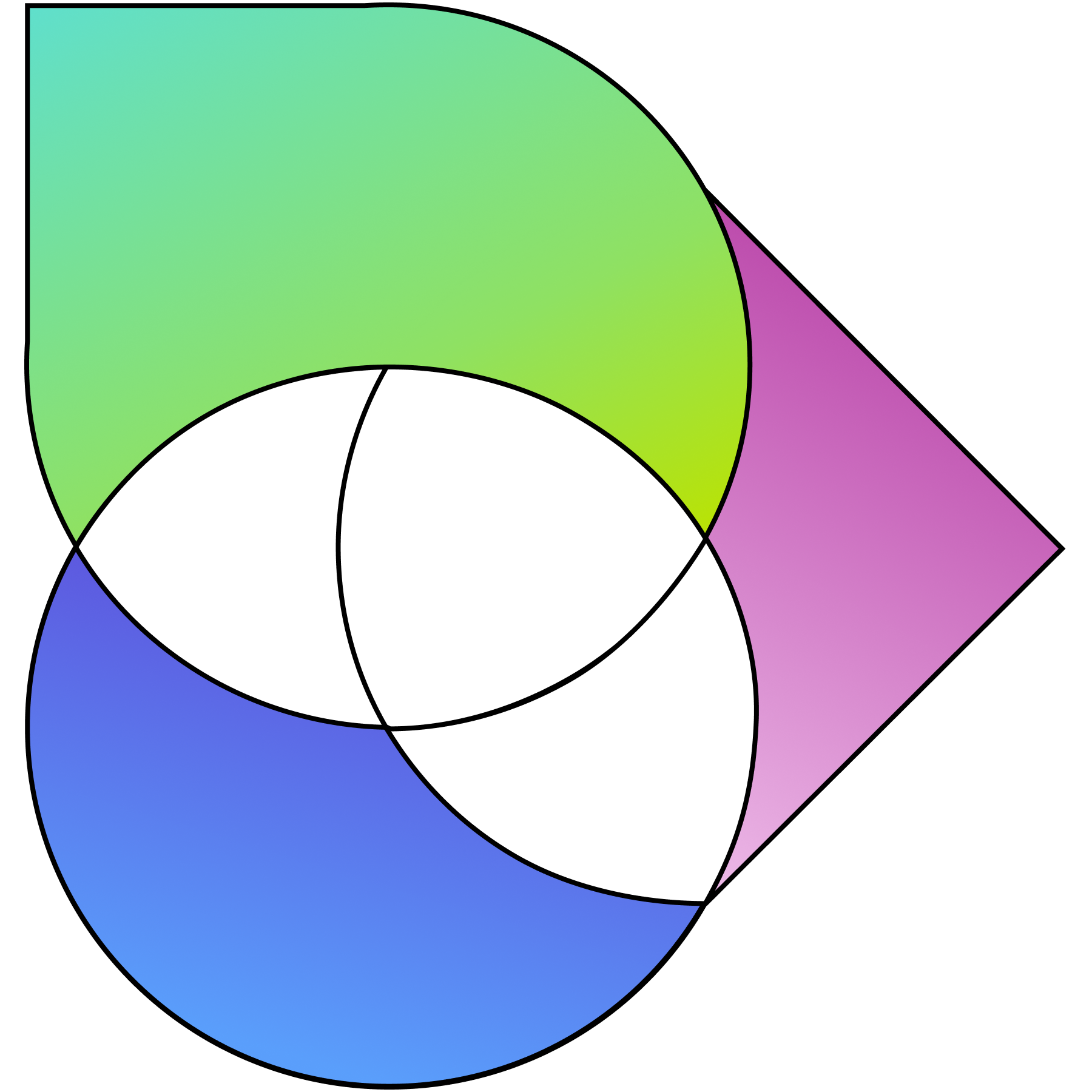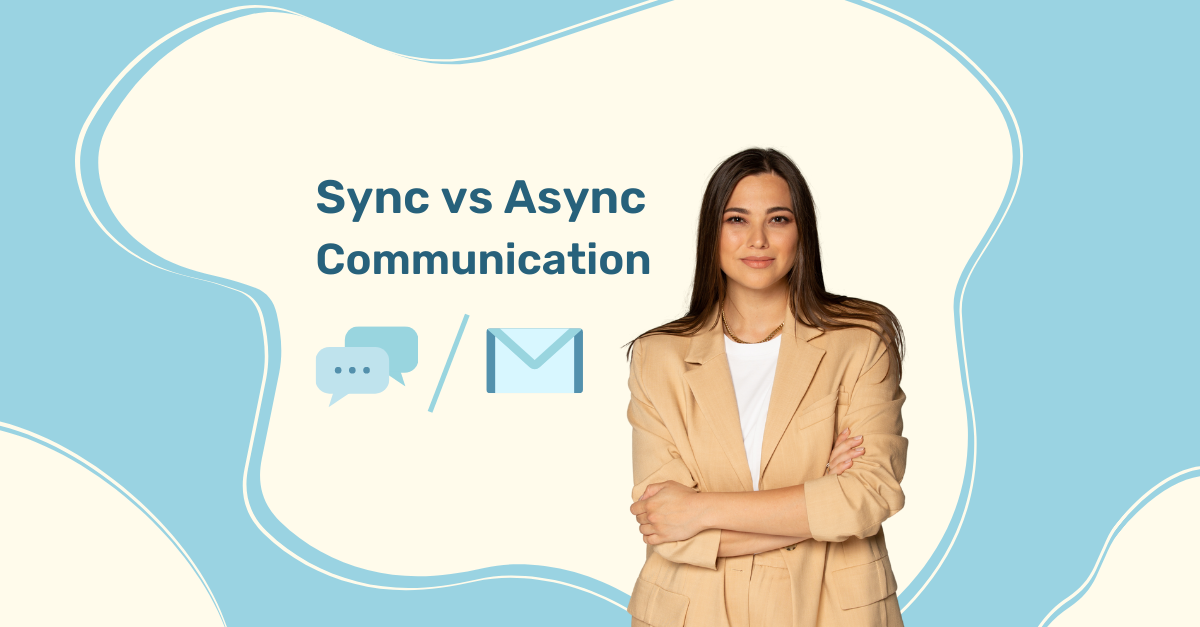Before we begin, can I ask you a question?
This article should not take you more than 10 minutes to read.
Do you think you will get at least one notification in the next 10 minutes?
How about more than one?
I feel we can all relate to the feeling of fatigue coming from being constantly bombarded with information, news, requests, questions, promotions, ads, and God knows what else.
The information fatigue in this remote work age is real!
But how did we get here?
Table of contents
- History of Synchronous and Asynchronous communication
- 40,000 BCE – Upper Palaeolithic Transition
- 30,000 to 20,000 BCE
- 10,000 BCE – Agriculture
- 5,000-3,000 BCE – Development of writing
- 1,200 BCE – Greeks and the Alphabet
- Common Era (AD)
- 117 AD – Roman Postal Service
- 1844 – Invention of the Telegraph
- 1876 – Invention of the Telephone
- 1976 – The Queen sends her first email
- 1991 – The first web page goes live
- 1995 – Instant messaging apps
- 2004 – Facebook
- Today
- Today – The state of Synchronous and Asynchronous communication
- What types of two-way communication exist?
- Pros and cons of Synchronous and Asynchronous communication
- How to make the best of synchronous and asynchronous communication?
- Make Tech your friend
- Conclusion
History of Synchronous and Asynchronous communication
Let’s start from the very beginning.
The Upper Palaeolithic Transition, about 40,000 years before the common era (BCE).
40,000 BCE – Upper Palaeolithic Transition
Okay, maybe not from the very beginning.
At this point in history, we have already existed for 160,000 years.
We could make basic communication such as “Me, Tarzan. You, Jane”.
But about 40,000 years ago we start drawing in caves.
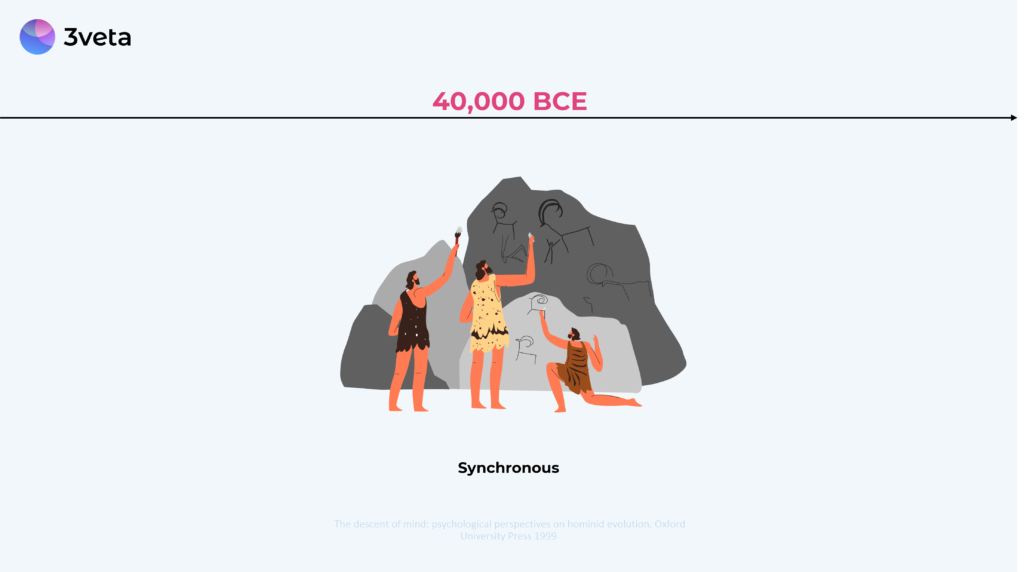
These drawings are some of the first signs of symbolic thinking.
Most scientists believe symbolic thinking is closely linked to our ability to speak and express ourselves.
Our ability to use language as we know it today.
Language, capable of expressing statements, questions, and intentions.
And thanks to this we can conclude that about 40,000 years ago we develop the first more complex type of synchronous communication.
30,000 to 20,000 BCE
For the next 20-30 millennia nothing really ground-breaking happens.
We continue to gather around the campfire and talk about how big the woolly mammoth we saw today was.

10,000 BCE – Agriculture
Around 10,000 BCE we have the first major development.
We develop agriculture.
Thanks to agriculture for the first-time people settle down and stop being nomads.
What happens is that we start hanging around much larger groups of people, for much longer.
Finding ways to communicate and collaborate becomes much more important.
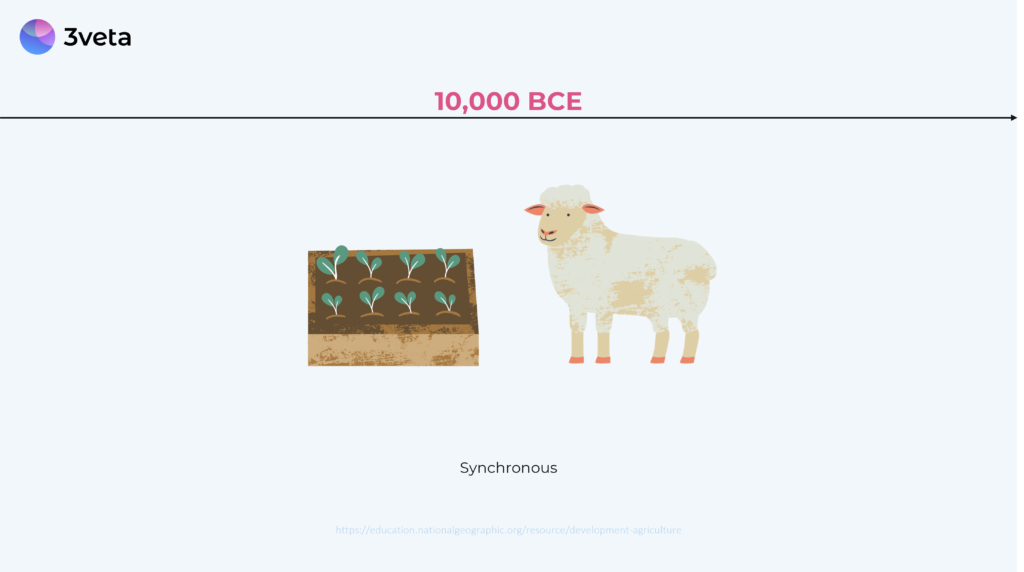
As a result, our language continues to develop.
5,000-3,000 BCE – Development of writing
Between 5,000 and 3,000 BCE, 3 writing systems developed in Sumer, Egypt, and the Indus Valley.
The earliest known is the Cuneiform, created in Mesopotamia, near present-day Iraq.
The one from the Indus Valley has never been deciphered.
But the one I want to talk about is the most widely recognized – the Egyptian hieroglyphs.
Hieroglyphs were a symbolic written language.
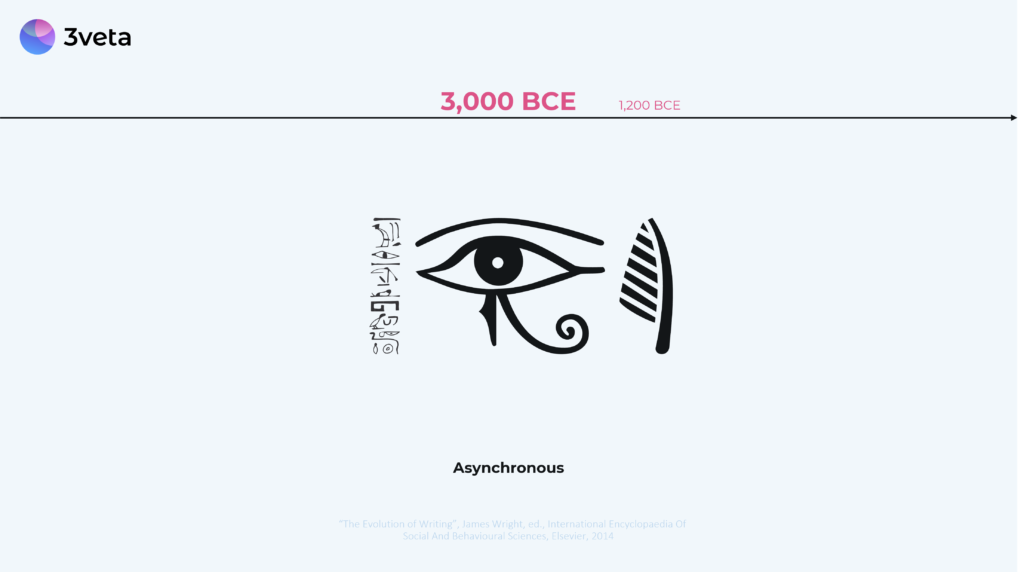
One, that is very hard to learn, read or write.
Scribes would go to school to learn how to read and write, and writing was their only job.
By the way, we get the word “Scribble” from the word “Scribe”.
1,200 BCE – Greeks and the Alphabet
Egyptians eventually simplified their pictographic writing system from drawing words to drawing sounds.
And around 1,200 Phoenicians invent the first major phonemic script or the Alphabet.
Containing only 24 distinct letters, it was the first script simple enough for common traders to learn.
However, Greeks upgraded this system by adding vowels to it.
This made it even easier to read, write and understand.
This democratized written language even further.
And speaking of Democracy, in practicing Democracy, Greeks starts putting a premium on spoken language and argumentation.
Socrates comes up with the Socratic method and starts asking people endless questions.
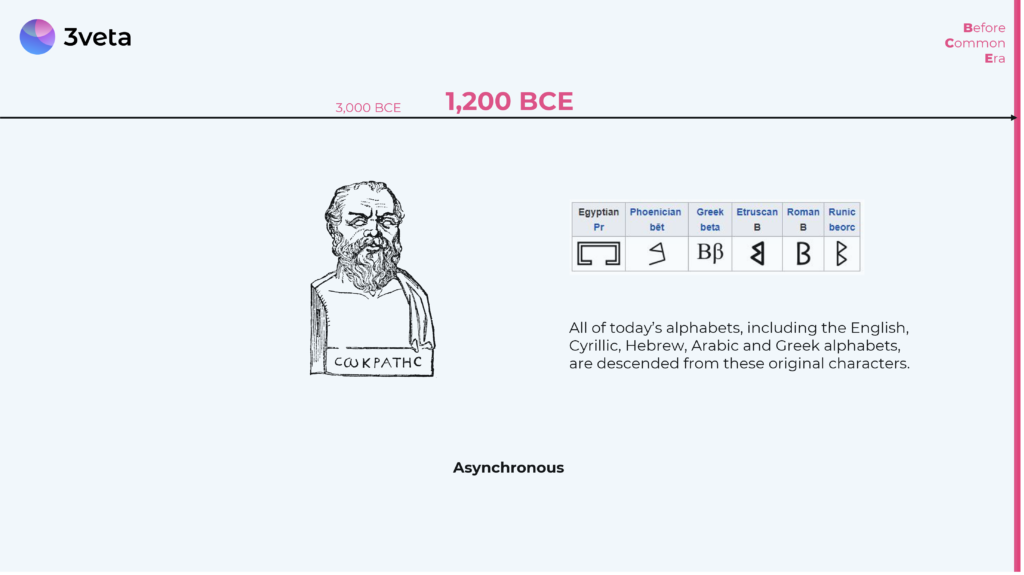
His students on the other hand eventually start writing down their own thoughts which advanced asynchronous communication not just from person to person, but each individual can now trace their thoughts over time.
This is probably one of the biggest advancements in cognition as a whole.
Common Era (AD)
And here we enter the common era. Naturally, we look into The Roman Empire and how the Romans understood the significance of asynchronous communication.
117 AD – Roman Postal Service
Jumping into the Common Era, we land in 117 AD, in the Roman Empire.
At this point the, Roman Empire reached its peak and spanned from Egypt to Great Britain.
For keeping this massive territory under control communication was key.
In fact, if you visit Rome today one of the largest remains from Roman time is the Roman Tabularium, where mail and public record were kept.
Of course, only the Emperor, his officials, and his friends could use this advanced postal service and the penalty for using it without a permit was… death.
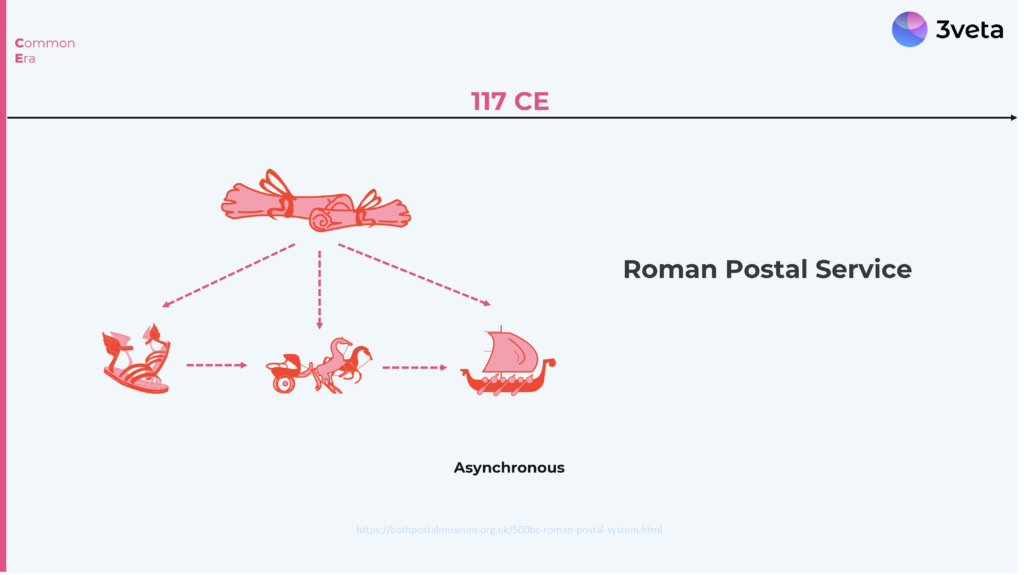
Nevertheless, in its best days, the emperor could send a papyrus scribe as fast as 240 km per day, and long distances were carried by foot, horse, and ship.
For its time, the Roman Postal Service was a remarkable system for asynchronous communication.
1844 – Invention of the Telegraph
Jumping another 1000 years forward, we begin the Age of Invention.
Of course, letters were being sent for 1,000 years, but other than the speed of delivery nothing much changed.
However, from the late 1800s, the jumps in time between technological advancements become smaller and the advancement itself becomes much more significant with each jump.
Developed between the 30s and 40s by Andre-Marie Amper and Samuel Morse, both of whose last names are pretty famous today, the Telegraph was a major step in the advancement of long-distance sync communication.
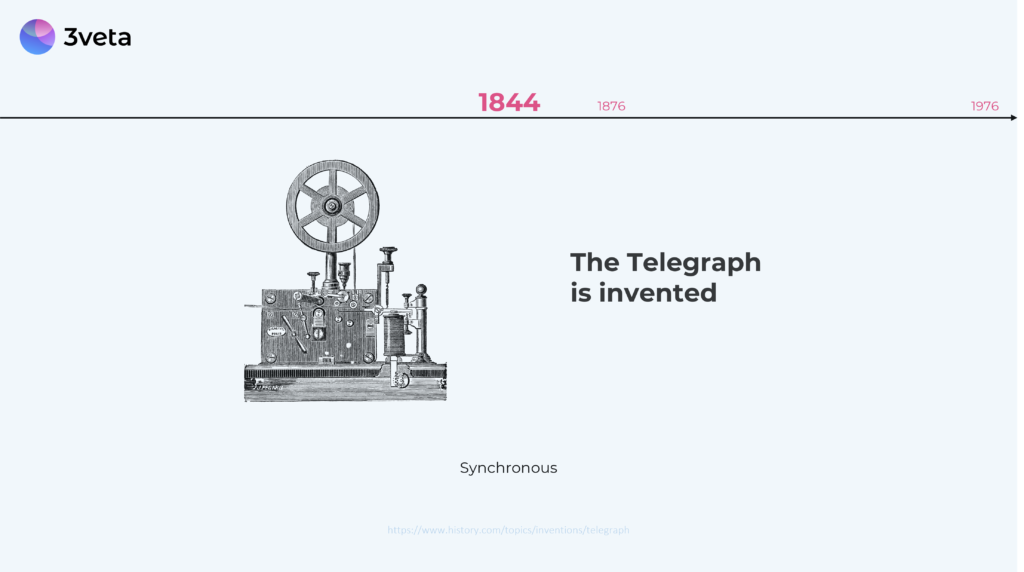
1876 – Invention of the Telephone
A measly (in the grand scheme of things) 30 years forward Alexander Bell invents the Telephone.
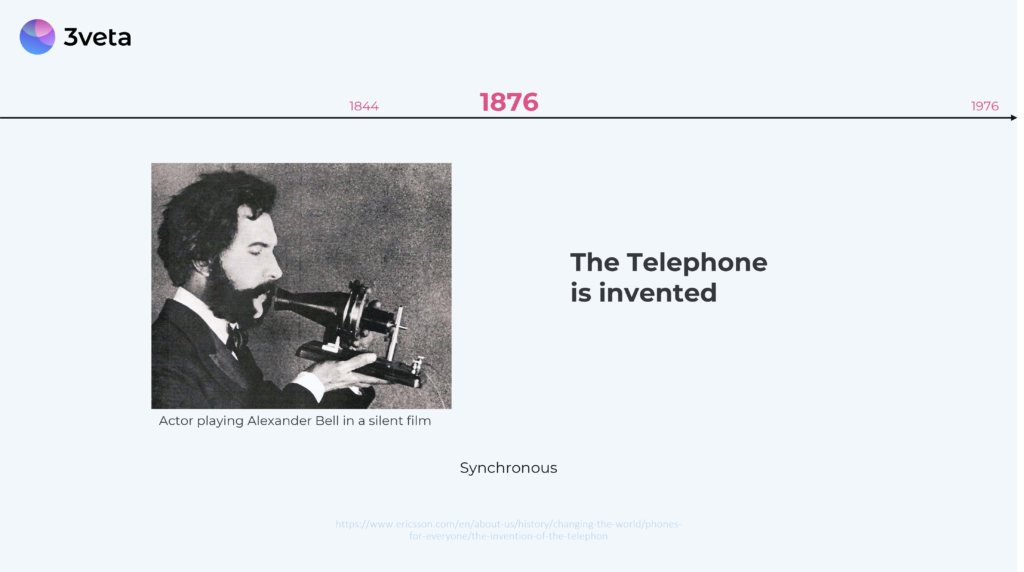
1976 – The Queen sends her first email
In just another 100 years we already have computers, and the Queen is sending emails!
Email is the first big breakthrough for asynchronous communication.
From the late 70s to this day, it is probably the most widespread tool for asynchronous communication.
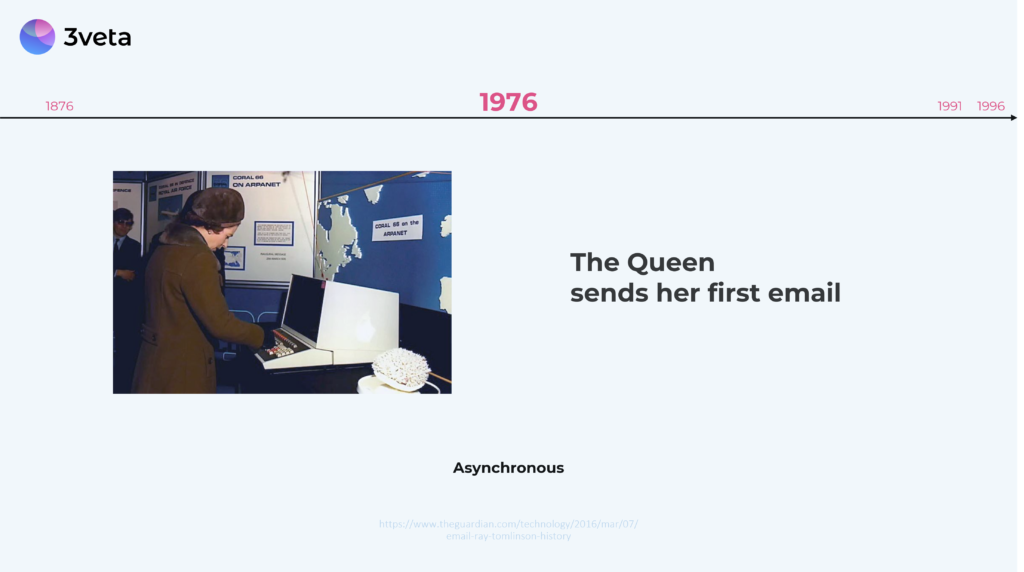
1991 – The first web page goes live
In 1991 the first web page goes live, and the world of communication will never be quite the same.
1995 – Instant messaging apps
Around 1995 instant messaging becomes ubiquitous with the launch of AOL Instant Messenger, mIRC, and ICQ.
All of these allowed people to communicate in real-time, over great distances, but also send a message which would be delivered later in time, mixing sync and async communication.
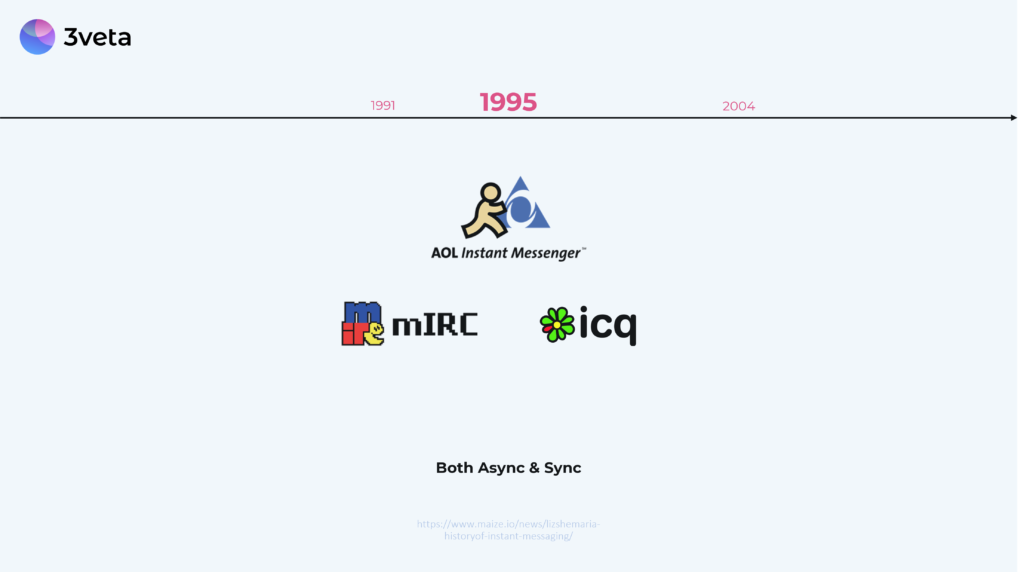
In AOL after logging in, you could hear the sounds of opening and closing doors when contacts on your Buddy List signed in or out: The mystery and anxiety of whether someone was online or offline and why they weren’t responding to your message was born.
2004 – Facebook
In 2003 MySpace was created and in 2004 Facebook, thus giving birth to Social Media as we know it.
As they say, the rest is history. But it’s history all of you here have been present for.
Today
And so we reach the present day.
And what do we have today?
Well, pretty much the same brain we had 40,000 years ago.
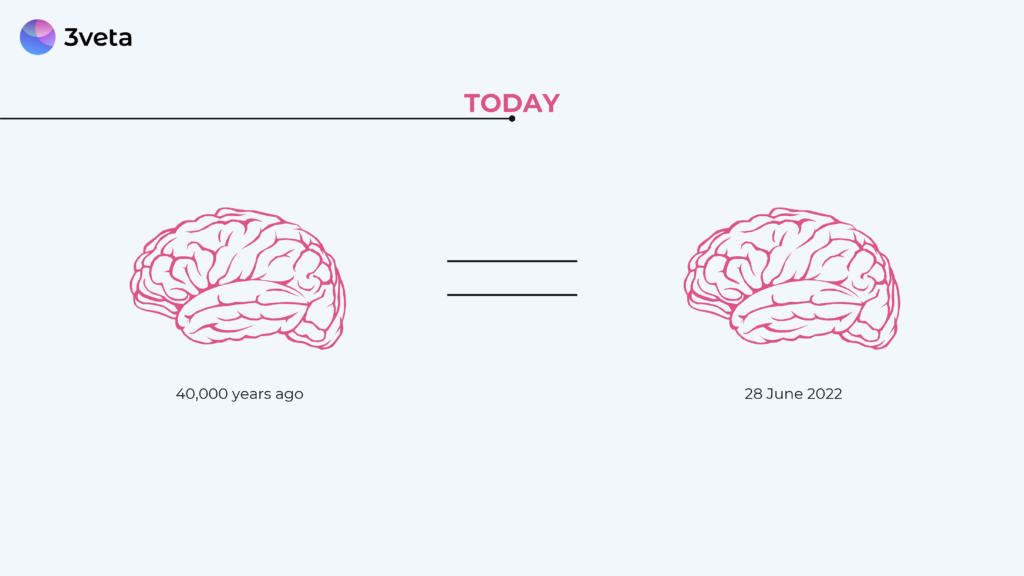
We have had many software upgrades in this time – from symbolic language to literacy, to digital communication.
But our hardware has stayed pretty much the same.
No wonder we’re sometimes losing focus and feeling overwhelmed.
Today – The state of Synchronous and Asynchronous communication
Thanks to our ancestors and millions of brilliant people before us…
Thanks to them we don’t need to wait for pigeons to carry our messages and we don’t need to worry about them getting lost along the way.
The perks of today
Thanks to synchronous communication at a distance today we can work from any point in the world (as long as it has decent internet).
We can become friends with people from way outside of our immediate communities and the places where we were born.
Thanks to asynchronous communication we can stay in touch with these easily regardless of the time zone they are based.

As digital nomads, this is how we would like to see ourselves.
The pitfalls of today
But we sometimes end up like this instead.

We are non-stop being blasted with information and communicated at.
And while one-way information such as TV, Radio, Spam mail, digital advertising, and most social media, can (in theory) be just blocked entirely, two-way communication cannot be avoided.
So, what can we do?
By knowing what types of information there exist and how to best use them, we can learn how to limit, filter, and disseminate the constant flow of communication heading our way.
And this is what I will attempt to do.
What types of two-way communication exist?
What types of two-way communication are there?
Two-way communication can be:
Synchronous communication is when you and your colleagues collaborate at the same time. Synchronous communication is real-time and assumes the presence of all parties.
Examples include face-to-face meetings, but also Zoom meetings, instant chat and just talking on the phone.
Synchronous communication is the cultural norm, and we can see why. It has been the norm for most of our existence on earth.
Asynchronous communication occurs when collaboration is not in real-time and could be stretched out for hours or days. You can communicate without needing another party present in real-time.
Examples of asynchronous communication include sending an email, sending a message on Slack without expecting an immediate reply, adding a comment on a work board, such as Trello, or passing back and forth a document.
It can also include sending voice notes and video recordings.
In this scenario, you’re still communicating but there’s no need for both parties to be together at the same time.
The main difference, therefore, is the real-time element.
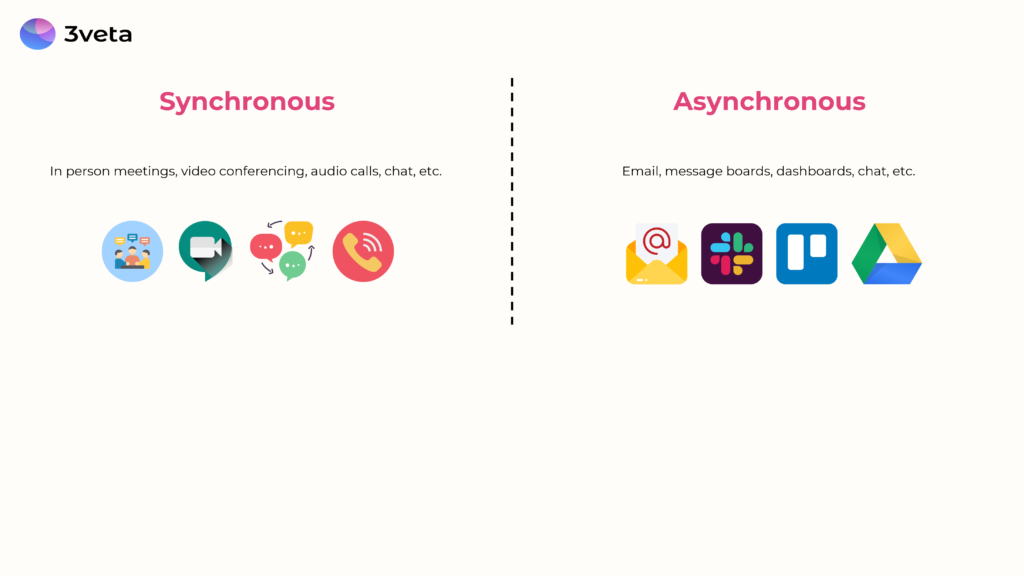
Which one is better? Synchronous or Asynchronous Communication?
There are proponents of both synchronous and asynchronous communication.
The people who want to get everybody to the office as soon as possible probably prefer synchronous communication and will tell you how much better it is.
On the other hand, we have people who never want to see the faces of their co-workers again, even on a video call.
These would usually be proponents of the asynchronous style of communication.
And asynchronous is gaining followers by the second. In the age of remote and hybrid work, many people are enjoy async and even jump to the extreme of wanting only async communication.
And there are many good reasons for it.

I, however, want to argue that there is a case to be made for both.
Otherwise, you wouldn’t meet with people in real-time, participating in synchronous communication.
Pros and cons of Synchronous and Asynchronous communication
Let’s start with an illustration of the pros and cons of the two types of communication. And then dive into them one by one.
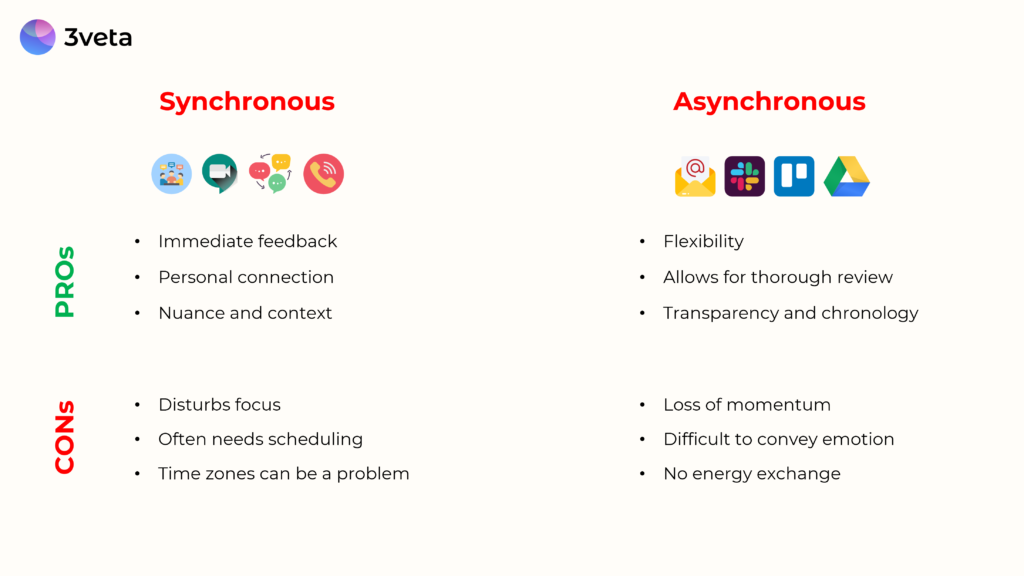
So, let’s compare them and see what the pros and cons of each one are.
Pros of synchronous communication and synchronous work
- Immediate feedback
The first pro of synchronous communication is immediate feedback.
Say I was delivering this article as a talk at some event.
I could start this talk with a question and get your immediate response. If I made a joke, I would immediately know immediately if it was funny.
- Personal connection
In a real-life setting, we would have a personal connection.
Retelling this article to someone in real life makes us much more connected. There would be something more that bonds us.
Unfortunately, while you are reading this article we are not establishing any deeper human connection.
You don’t feel the pathos with which I am talking (writing) about this topic!
- Nuance and context
Nuance and context are more often perks of synchronous communication.
For instance, this article was initially presented as a talk at the Bansko Nomad Fest. It was communicated verbally by myself, Maria Valchanova, and was followed by a Q&A session, providing much more specific information.
After the talk, we grabbed a beer with some of the participants and discussed the topic in much more detail – clearing any and all doubts they had.
Reading this article you also don’t get a feeling of everyone else who reads it. If they are digital nomads (as the initial intent) you lack the context of how cool, free-spirited, and international they are.
Pros of asynchronous communication and asynchronous work
- Flexibility
On the other hand, since you are reading this article, you can easily pause for a minute and go make yourself a cup of coffee.
You would have the flexibility to continue reading it whenever and wherever you want.
- Thorough review
Once again, the written format of this article allows you to Google a bunch of tiny details.
I have also placed put references all around the article, allowing you to follow and examine them thoroughly. Something live participants did not have the chance to do.
Thorough review is a perk of asynchronous communication.
- Transparency and chronology
This article is here on this blog right now.
But this means it is on the Internet forever.
Once online – always online.
There is the timestamp and however many changes I make, each one of them would be stored somewhere on the internet.
All the information is easily verifiable.
Don’t trust something I have written? Feel free to Google it.
Many of the mistakes you do in real-life could be overlooked and/or forgotten.
Cons of Synchronous communication
What about the other side?
What are the downsides of both sync and async communication?
- Disturbs focus
Synchronous communication often disturbs focus – because you can only do a single thing synchronously.
If you’ve ever been in an office setting, you know pretty well how disturbing could it be for someone to just walk to you and state their request.
Whether it be a simple question or an invitation to go grab some coffee.
Wherever you are reading this, if you get a phone call, you could just pause reading and pick up.
In real-life picking up your phone could cause some commotion, disturbing the other party or even everyone in the office.
- Scheduling
Attending any kind of meeting, talk, or event requires some kind of scheduling.
Reading an article is often more impulsive and scheduling reading time would even sound a bit strange.
Generally, scheduling is the biggest burden of sync communication.
- Time zones
Finally, and this I think is related to scheduling, but Time Zones are a real pain.
Even when you do manage to be in the same room to meet, you still might be jetlagged and not at your best depending on where you’ve arrived from.
Async simply doesn’t care about time zones.
Cons of Asynchronous communication
But async also has its flaws.
- Loss of momentum
And I think the most prominent issue is the loss of momentum.
Say you did make this cup of coffee to finish reading the article.
You’ve lost momentum.
You stopped reading and now it takes your mind much longer to come back to the flow of the article.
Sync meetings almost always have momentum. You start doing the meeting and you never stop until it is over.
- Difficult to convey emotion
This is especially true here.
Emotion is completely lost.
You are reading this article with your own voice in your head (or no voice at all). You don’t know how I speak and probably you will never know how I would deliver this.
Apart from this example, here’s a more everyday one.
I am sure you have received a rude email or text message, but then it just turns out they are from a different culture. One where people skip the niceties and get straight to the point. Maybe German.
No offense to German readers. I have lived and worked in Frankfurt and people do get to the point much faster than in other places. Work was definitely more efficient but to some point at the expense of small talk.
- Energy exchange
Reading this article there is just information.
There is no energy exchange.
Actually, it is your device sucking energy away from you.
In real life, you exchange energy with the other party. A motivational talk could empower you and actually give you energy!
Because we, people, are social beings.
How to make the best of synchronous and asynchronous communication?
Knowing all the pros and cons, how can we make the best out of both?
I think we need to know when to use each, compartmentalize and turn tech into a friend.
Know when to use sync or async communication. An exercise.
After we’ve seen the pros and cons of each, let’s do a quick exercise.
Here’s an illustration of some everyday activities. Apparently, all of them could be both sync and async.
Try to determine whether they should be done in sync or async manner (using the pros and cons from above).
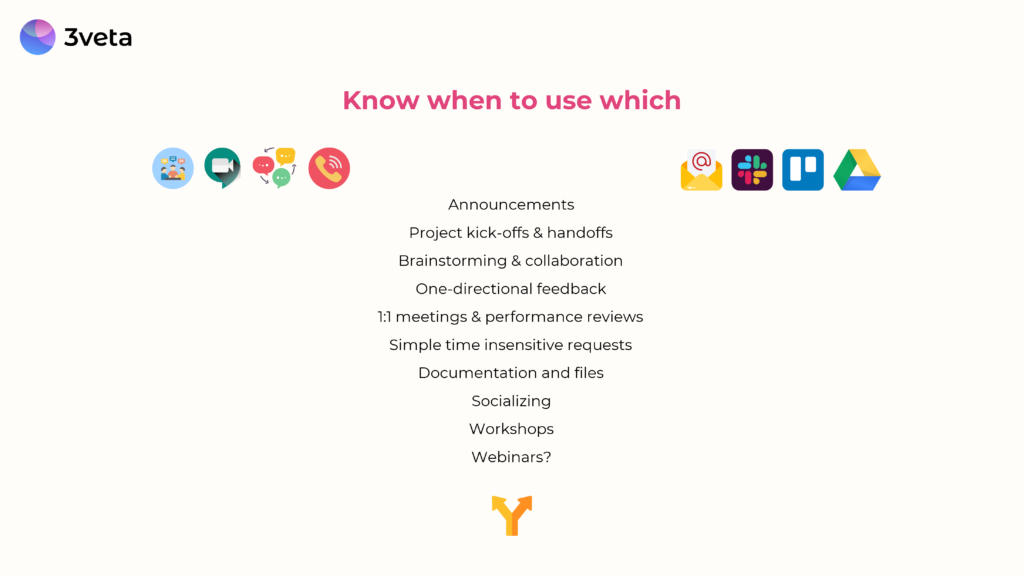
Know when to use sync or async communication. Solution.
- Announcements
Those best go in the asynchronous bunch. Why? Transparency and chronology
- Project Kick-offs and Handoffs?
Synchronous. Why? Personal connection.
- Brainstorming and collaboration?
Synchronous. Why? Instant feedback.
- One-directional feedback?
Async. Transparency & Chronology
- But 1:1 meetings & performance reviews?
Sync. Personal connection
- Simple requests?
Async. Transparency & Chronology
- Documentation and files?
Async. Allows for Thorough review
- Socializing?
Sync. Personal connection
- Workshops?
Sync. Immediate feedback
- Webinars?
Sync. Flexibility
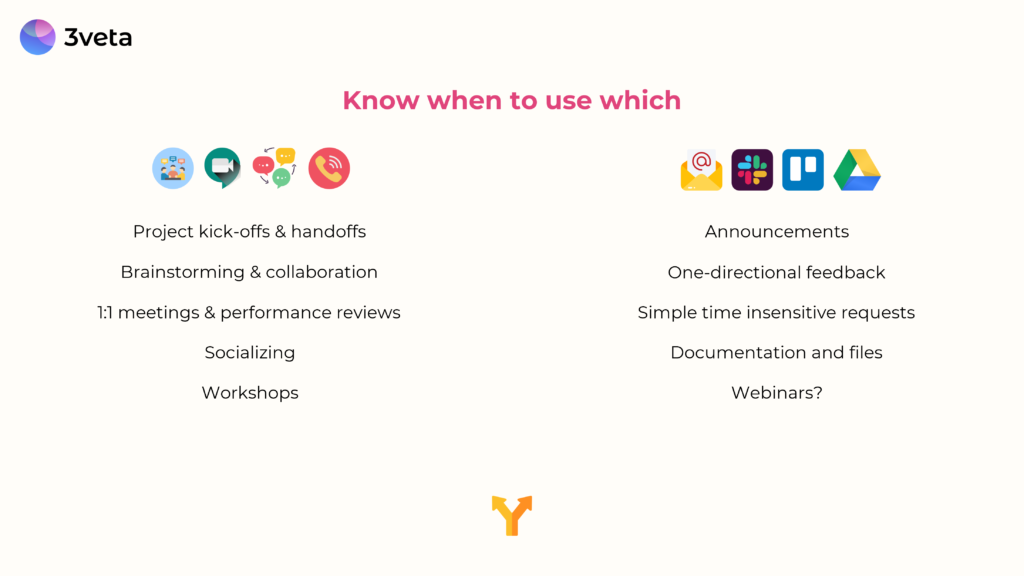
Most of these might seem quite obvious, and we don’t necessarily think about them.
But let me tell you a story about why this is so important.
When we were signing a contract with a freelance development company, they could have just sent us over the contract, and we would have signed it.
But they insisted we meet and go get a beer first.
As a result of that simple non-formal face-to-face meeting, we kicked off the project and already were much more collaborative, open, and friendly with each other.
Sync communication builds true, meaningful connections.
It builds trust.
Thanks to this one meeting, we would hire and have hired these guys over and over again.
Finally, keep in mind that you are reading nothing groundbreaking.
However, you are becoming more aware.
And that’s the whole point!
Compartmentalize
What else can you do to become a better communicator?
Compartmentalize.
By compartmentalizing and focusing on one thing at a time we can reduce the mental load on the brain.
But how do you do this? Here are my suggestions:
- Bundle your communication
- Schedule time for deep work
- Don’t be afraid to fully disconnect.
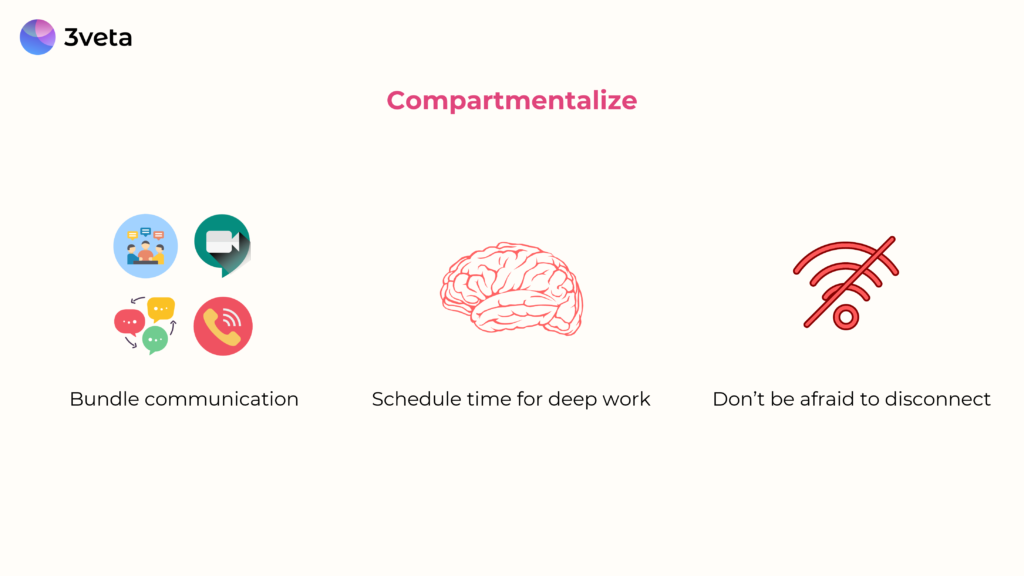
Bundle communication
Try to avoid mixing multiple communication streams at the same time. The simplest example of that would be not to reply to notifications in Slack while on a video call.
A higher level of bundling is scheduling your communication in blocks.
For example, my sync communication I have split into internal and external communication.
Internal communication would be: calls with the team.
These are usually scheduled before noon – this way we can kick off the day, set the agenda, prioritize, and unblock the flow of work of others.
On the other hand, the communication I consider external is calls with people outside of the organization.
This time is strictly limited in my calendar to afternoons from Tuesday to Thursday.
I do not want people to be able to disturb me on Monday, as this is usually the busiest day.
And I do not people to be able to book me for Friday as this is when I would usually travel.
But bundling these calls in set times also allows me to concentrate on them and prepare for them better.
The same goes for async communication.
99% of what comes through can usually wait.
It’s been proven that blocking notifications completely leads to more stress than bundling them up.
So, I have scheduled all the notifications on my phone to appear at the end of the working day.
I do a few natural check-ups of my work channels during the day but avoid getting distracted randomly.
You never know when to expect messages. So, each message that comes alerts your brain, imposing extra strain on it, and distracting you from the task at hand.
Do not let async communication become sync.
Schedule time for Deep Work
Another thing that I have found revolutionary is scheduling time for deep work.
Carving those hours in the day really is difficult.
But to do something meaningful requires your full attention.
For example, I knew that creating and preparing this article would require me to sit down and work for hours.
There is no way I could have done it by working on two paragraphs and one idea per day over a couple of weeks.
Instead, I scheduled long bulks of hours in one week. I made sure to block them off in my calendar in advance and when the time came, I switched off from the rest.
No calls, no outside communication, no distractions.
No stress.
Don’t be afraid to fully disconnect
I know it can be hard.
The pressure to always be online and available is one of the biggest ones people face when switching to fully remote work.
So, to tackle this – schedule your availability.
And in that schedule, don’t be afraid to become fully unavailable.
Only this way you can switch off and take control of your time and attention.
Information has become so ubiquitous that it has become worthless.
What is of value is our attention.
Attention is a resource and we only have so much of it.
Make Tech your friend
Finally, make tech your friend.
I know what you’re thinking… oh no, not more apps… I am already using so many apps…
But this is just like the Egyptians thinking “Oh no… not more symbols. We already have so many symbols.”
The technology that lives in our brain as literacy, has evolved for thousands of years and has kept changing.
However, changes that took 1000s of years before, are now taking just a couple of months.
Our speed of development is exponentially faster than ever before.
And if we don’t take advantage of the tools available to us, we miss out on so much growth and development.
💡Need help making tech your friend?
I’d be happy to have a call with you so we can discuss how you can leverage tech for your organization. Feel free to book a call with me over here!
Re-evaluate your tech stack every 6-12 months
If I could give you just one piece of advice on this, it would be to re-evaluate your tech stack every 6-12 months.
But that sounds rather vague, so let me give you a quick 3-step recipe of how to actually do it.

Try out what’s new out there
You have probably heard about Notion. It is one of the fastest-growing apps out there.
But have you and most people you know tried it?
I don’t think so.
But if so many people are using it, it must be good for something…
And it is good, for way more than one thing!
You can keep tabs on your projects, take notes, look at progress bars, and GANT charts and use ready-made templates to save you time.
This brings me to my second point…
Use multipurpose apps & consolidate
Notion is one example of an app that can take the place of at least 2 other ones you are using.
Instead of using Zoom + Calendly, you can try out an app like 3veta, which combines an internal team scheduling tool, a booking link, as well as a super HD video.
All of the perks of 2 apps, in one place, for a lower price.
There are tons of apps like this one to help you optimize both time, effort, and costs.
Use Tech to play to your strengths
We’ve been talking about sync and async communication so far, and their advantages and disadvantages.
But what if you could use technology to change the game and use the advantages of synchronous communication asynchronously.
And Loom can really help with that.
For example, when handing off a project, you can record a video of yourself summarizing it.
This would instantly add a personal touch, make you stand out, be more memorable, and could lead to that person hiring you again, just because you have now created a connection.
Even though you did it on your own time and skipped the scheduling and hassle of a video call.
Conclusion
In conclusion, I would like to return to the wisdom of the Greeks, with this maybe less famous quote by Seneca.
Nothing is ours, except time.
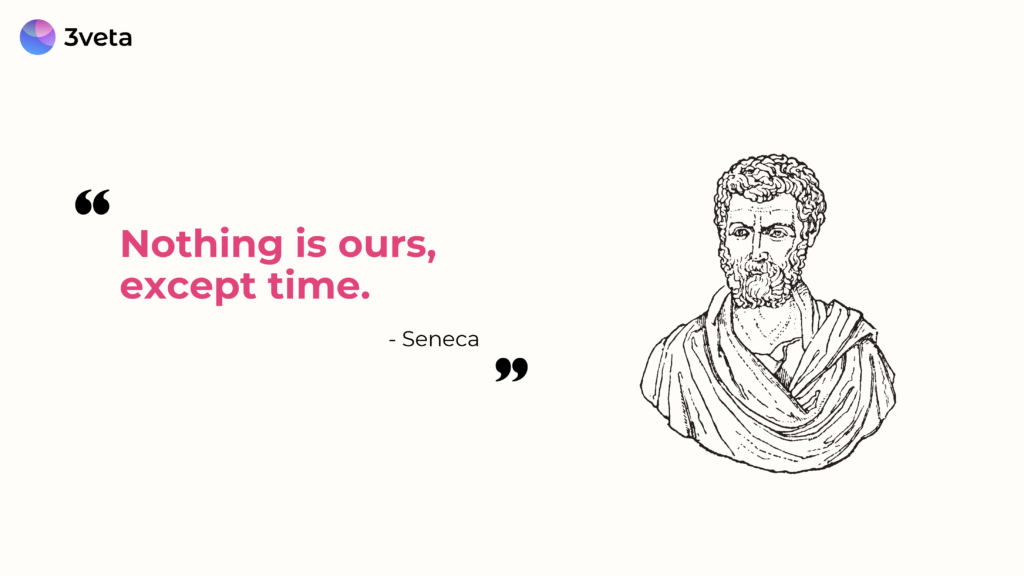
Use your time wisely.
Get your work done, make meaningful connections, and keep your brain sane.
By using both sync and async communication to your advantage, it is possible.

Maria Valchanova
After working as the right-hand woman for the HR Director @Hilton for Europe, Middle East and Asia and as a Tech and Management Consultant, I decided to put my experience to a good use and become an entrepreneur.
Starting 3veta has been an exciting journey and a fantastic learning experience so far. Happy to connect on LinkedIn.


